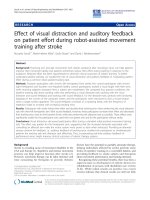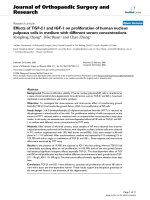Báo cáo hóa học: " Implications of GMO cultivation and monitoring-series" doc
Bạn đang xem bản rút gọn của tài liệu. Xem và tải ngay bản đầy đủ của tài liệu tại đây (130.05 KB, 2 trang )
EDI T O R I A L Open Access
Implications of GMO cultivation and
monitoring-series
Gunther Schmidt
*
, Winfried Schröder
Genetic engineering is a technological approach that
allows for the application of new genetic material across
species borders. It is assumed to yield specific benefits,
e.g., increased food production, decreased use of pesti-
cides and herbicides, and improved food quality. How-
ever, after more than a decade of commercial
experience in some countries outside Europe, it seems
apparent that several i nitial expectations could not be
met, for exam ple, the overall reduction in pesticide use.
Unlike chemicals that degrade by time, genetically modi-
fied organisms (GMO) as well as their decomposition
products have the potential to proliferate and persist in
the environment, eventually without the possibility of
removing them once they have been released. T hus,
concerns have been raised about potential adverse envir-
onmental impacts of the GMO and about potential
implications on the c oexistence between conventional
and genetically modified production. This makes risk
assessment as well as monitoring highly challenging
tasks towards minimising the risk of adverse effects.
Ecological, agricultural and economic implications
resulting from t he cultivation of GMO at large spatial
scales are currently discussed in science, administration
and in the context of agricultural practice. A challenging
task in this context is how to assess large-scale and
long-term effects of GMO release in the approval proce-
dure, in the planning of coexistence measures and in
post-market monitoring regarding environmental as well
as food monitoring. The international conference ‘Impli-
cations of GM Crop Cultivation at Large Spatial Scales’
(GMLS) was held at the University of Bremen first in
April 2008. In March 2010, a second edition of the co n-
ference (GMLS II) was initiated. Presenter s from
11 European and overseas nations contributed new
scientific findings on risk analysis of GMO and large-
scale assessments of environmental effects. As it was for
the first GMLS conference in 2008, the results were
documented on the website . Topics
include empirical work concerning findings on GM
traits, dispersal of GMO, and possible effects on non-
target organisms as well as risk assessment, theoretical
concepts and methodological aspects such as modelling
and data analysis facing large spatial and temporal
dimensions. Strategic implications for good governance
and approaches for unknown effects h ave been dis-
cussed from a social-ecological perspective. GMLS is
part of the studies on systemic risks funded by the
BMBF
a
in the call on Social Ecological research. In this
context, scientific findings are linked to social considera-
tions on how nature and the human society mutually
influence each other. This interdisciplinary approach
aims at a deeper understanding of the following mutual
response: How do social actions shape the environment,
and, vice versa, how do environmental processes impact
the success of social activities–agriculture as well as
other natural resource uses.
This special series publishes some key contributions
presented at the GMLS II conference. The articles
describe different aspects of large-scale c ultivation of
GMOs:
Overview of the series, thematically oriented:
1. A case study of GM maize gene flow in South
African Chris Viljoen, Lukeshni Chetty
2. Setup, efforts and significance of a GMO monitor-
ing program - An Austrian case study Kathrin
Pascher, Dietmar Moser, Stefan Dullinger, Leopold
Sachslehner, Patrick Gros, Norbert Sauberer,
Andreas Traxler, Georg Grabherr, Thomas Frank
3. A modeling assessment of geneflow in smallholder
agriculture in West Africa Denis Worlanyo Aheto,
Hauke Reuter, Broder Breckling
4. Monitoring of Bt-maize in Germany by mea ns of
Open Source based WebGIS Lukas Kleppin, Gunther
Schmidt, Winfried Schröder
5. Environmental Risk Assessment of Genetically
Modified Plants - Concepts and Controversies
* Correspondence:
University of Vechta, PO-Box 1553, 49364 Vechta, Germany
Schmidt and Schröder Environmental Sciences Europe 2011, 23:2
/>© 2011 Schmidt and Schröder; licensee Springer. Th is is an Open Access article distributed under the terms of the Creative Commons
Attribution Licens e ( nses/by/2.0), which pe rmits unrestricted use, distribution, and reproduction in
any medium, provided the original work is properly cited.
Angelika, Hilbeck, Matthias Meier, Jörg Römbke,
Stephan Jänsch, Hanka Teichmann, Beatrix Tappeser
6. Genetically modified crops safety assessments:
present limits and possible improvements. Gilles-
Eric Séralini, Robin Mesnage, Emilie Clair, Steeve
Gress, Joël Spiroux de Vendômois, Dominique
Cellier
7. From risk assessment to in-context trajectory
evaluation: GMOs and their social implications
Vincenzo Pavone, Joanna Goven, Riccardo Guarino
8. Systemic risks of genetically modified crops: the
need for new approaches to risk assessment Hartmut
Meyer
to be continued
The conference emphasised the necessity of indepen-
dent and publicly accessible research results for GMO
investigations. The conference illustrated that GMO risk
assessment can build on relevant information, e.g. refer-
ring to biochemical characterisation, physiological and
agronomic studies. However, considerable gaps exist in
the assessment of biodiversity effects, and how non-target
organisms would be impacted by GM crop cultivation.
Landscape and regional studies are even scarcer. Uncer-
tainties and the possibility to come up with much mor e
reliable test results exist also with regard to human
health aspects. Considerable scientific work has to be
done to solve the remaining open questions.
Endnotes
a
Federal Ministry of Education and Research
Received: 24 January 2011 Accepted: 2 February 2011
Published: 2 February 2011
doi:10.1186/2190-4715-23-2
Cite this article as: Schmidt and Schröder: Implications of GMO
cultivation and monitoring-series. Environmental Sciences Europe 2011
23:2.
Submit your manuscript to a
journal and benefi t from:
7 Convenient online submission
7 Rigorous peer review
7 Immediate publication on acceptance
7 Open access: articles freely available online
7 High visibility within the fi eld
7 Retaining the copyright to your article
Submit your next manuscript at 7 springeropen.com
Schmidt and Schröder Environmental Sciences Europe 2011, 23:2
/>Page 2 of 2









